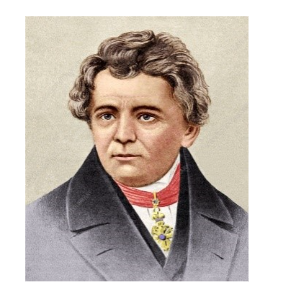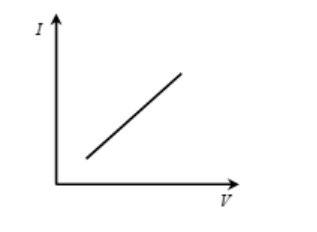Table of Contents
Ohm’s law is one of the important laws to understand the functioning of electrical and electronics-based circuits.

Flow of electricity in a wire is analogous to flow of water in a pipe (You cannot see the former but you can see the water flow). They are similar in many ways.
Before we formally state Ohm’s law, let us get some understanding of electrical quantities referred to in explaining Ohm’s law.
Current
Imagine an electrical wire in your household which is generally made of copper. Copper is a conductor and conductors have huge collection of free electrons which belong to the wire instead of belonging to any specific atom. Let us assume this wire is connected to a source of electrical power like a battery or a cell. When the power supply is switched “OFF”, these free electrons move about at random inside the wire. But when power supply is switched “ON”, the same electrons in the wire now gain an additional, guided motion. Due to this additional motion, electrons now move along the length of the wire, though they very much continue to possess the random motion that they earlier had.

Random motion of electrons in a metal
But when battery is connected, electrons are guided as a group down the length of wire.

Net result is, electrons move down the length of the wire as a guided team as if they have a definite purpose to achieve now, even as they continue to play with each other (performing random motion) as they move. You need an external aid to achieve this purpose. This guidance to electrons is given by a cell/battery. Battery gives “direction” to electrons, you can say!
Current is measurable: Next imagine an area of cross-section of the wire and you are asked to count number of electrons that crossed this cross-section in a given duration of time t, counting both numbers: those moving from left to right (nl) through the cross-section and also those moving from right to left (nr) through the cross-section. At the end of counting, you have two numbers with you. Subtract these two numbers to get n- (nl) – (nr)
In the absence of current, n will be zero or close to zero. This is called zero current.
In the presence of current, this number is non-zero. Battery has ensured that if say billion/trillion electrons crossed from left-to-right then hardly 2-3 or a few 10s or 100s crossed from right-to-left. So, n is huge now!
CURRENT IS RATE OF FLOW OF NET CHARGE THROUGH A CROSS-SECTION. If charge on each electron is e, then
Current, I = Net charge/time = ne/t
Resistance
When water flows in a horizontal pipe, we know it stops after some tome. This is due to the friction offered by the walls to the flow of water. To maintain the flow of water, a continuous external force is required.
In a current-carrying wire, electrons collide with each other and with the atoms as they move. This collision is exhibited as resistance to current flow.
Resistance offered by a metallic conductor depends on the material of the conductor, its dimensions and temperature.
Potential difference
Potential difference is the external “force” that electrons gain that keeps them moving through the wire. Potential difference is also referred as electrical pressure to help maintain current, just like hydrostatic pressure difference helps in maintaining water flow through a pipe, connected between two containers having water upto different heights.
Electromotive force
Each battery or cell is an agency which has a certain electrical pressure between its two terminals. When these terminals are connected to two points in an external electrical circuit, then a part of this electrical pressure is made available between those two points of the electrical circuit. This electrical pressure or potential difference across the ends of the wire drives current through the circuit elements connected between those points.
Unit of electromotive force or potential difference is volt.
Statement of Ohm’s law: Ohm’s law states that the current flowing through a conductor between two points of the conductor is directly proportional to the potential difference between the two points, provided all physical conditions and temperature remain constant.
If I is the current between the points, V is the potential difference between the points, then
I ∝ V
= I = kV
where, k is a constant of proportionality.
k = 1/R, where is the electrical resistance between the two points.
So, I = 1/R x V or
V = I
Units:
- SI unit of potential difference is volt , potential difference is measured using a voltmeter.
- SI unit of current is ampere, current is measured using an ammeter.
- SI unit of resistance is ohm.
Experimental verification of Ohm’s law:

Using the circuit shown in the adjacent diagram, we can verify truth of Ohm’s law.
Here the resistance of rheostat is varied. This varies the current (I) through the circuit which is measured by the ammeter. Voltmeter connected across the resistance R measures the potential difference (V) across the resistor. For various values of current, values of potential difference are recoded. A plot of V versus is I drawn, with V on y-axis and I on x-axis. The graph is fairly a straight line, confirming Ohm’s law.

Please note that slope of the graph gives reciprocal of resistance
(∵ I/V = 1/R).
Ohm’s law gives a linear relationship between potential difference and current.
Ohm’s law is not universally true!
You take a wire. Apply a certain potential (V) difference across its ends using a voltmeter. Measure the current (I) flowing through the wire using an ammeter. Take the ratio V/I. This ratio is called the resistance of the wire. So, the formula R = V/I represents the definition of resistance of a material.
Now let us change potential difference across the ends of the wire and note down the current again. We do it many times and tabulate the observations.
| Potential Difference (V) | Current (I) | Resistance R= V/I |
| V1 | I1 | R1 |
| V2 | I2 | R2 |
| V3 | I3 | R3 |
| … | … | … |
| Vn | In | Rn |
If we find R1 = R2 = R3 = … = Rn, then we say the wire’s resistance is independent of the voltage and current and that the wire obeys Ohm’s law in the voltage range V1 to Vn.
On the other hand, if we find resistance of the wire to vary as voltage changed, then we would say resistance of the wire was dependent on voltage or current, and that the wire does NOT obey Ohm’s law.
Equation V = IR is always true. It is the defining equation of resistance. If resistance is constant, then the equation is said to obey Ohm’s law. On the other hand, if resistance changes, then the same equation is said to NOT obey Ohm’s law.
Summary
- Definition of resistance is: R = V/I
- Ohm’s law means constancy of resistance, independent of voltage/current.
- But whether will be constant (for any value V of or I ) or not, it depends on material and temperature.
- Ohm’s law is obeyed by most of metallic conductors at ordinary temperatures.
- Ohm’s law is not obeyed by gases crystal-rectifiers, thermionic valves, transistor, carbon, mica, vacuum tubes, thermistor and most of the electrolytes. These devices or substances are called non-linear or non-ohmic devices. Ohm’s law is not valid for a diode as shown by below graph.

- Variation of voltage-current relationship for GaAs is non-linear as shown below.

- Even for metallic wires, Ohm’s law is valid for low currents. At higher currents, temperature of a wire changes (thereby resistance changes) such that Ohmic (linear) behaviour is no more followed.
Ohm’s law magic triangle

The above magic triangle helps to remember three formulae
- V = I x R
- R = V/I
- I = V/R

Problems
If potential difference between the ends of a heating element is 220V, and current through it is , then what is its resistance?
Ans: R = V/I = 220/5 = 44Ω
A resistor is connected to a battery through connecting wires. Current flowing through the resistor is measured as 0.25A. If the battery is replaced by another battery, the current is found to be 0.50A. What is the ratio of potential difference between the ends of the conductor in the two cases, if the wire obeys Ohm’s law?
Ans: Here resistance remains same. Using Ohm’s law,
R = V1/I1 = V2/I2
V1/0.25 = V2/0.50
V1/V2 = O.25/0.50 = 1/2
Frequently Asked Questions on Ohm’s Law
State Ohm’s law.
Ohm’s law states that the current flowing through a conductor between two points of the conductor is directly proportional to the potential difference between the two points, provided all physical conditions and temperature remain constant.
Which substances or devices do not obey Ohm’s law?
Ohm’s law is not obeyed by gases crystal-rectifiers, thermionic valves, transistor, carbon, mica, vacuum tubes, thermistor and most of the electrolytes.
Is Ohm’s law obeyed by metals at all temperatures?
No, it is not obeyed at all temperatures. At higher temperatures, resistance is not constant.
Is Ohm’s law valid for even high currents?
No. At high currents, temperature of conductor increases. This changes their resistance.







